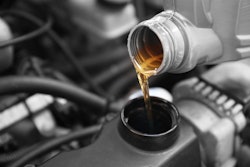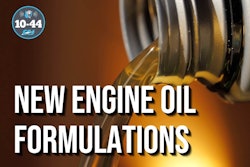We’ve done a few episodes over the years about engine oil viscosity, specifically how lower viscosity oils can improve fuel economy, but it's time to dive into how viscosity affects performance of the engine.
Contents of this video
00:00 10-44 intro
00:29 Viscosity’s influence on engine components
00:56 What is viscosity?
02:16 Sheer rate and viscosity
05:27 What do the numbers on a bottle of engine oil mean?
07:04 0W20 and diesel engines
09:10 Benefits of lower viscosity heavy-duty engine oil
10:52 Fuel economy gains
11:58 Viscosity below the OEM recommendation
Jason Cannon:
CCJs 10 44 is brought to you by Chevron Delo, heavy duty diesel engine oil. Now there's even more reasons to choose delo diesel engine oil viscosity. What is it and why does it matter to you? You're watching CCJs 10 44, a weekly episode that brings you the latest trucking industry news and updates from the editors of CCJ. Don't forget to subscribe and hit the bell for notifications so you'll never miss an installment of 10 44. Hey everybody, welcome back. I'm Jason Cannon and my co-host. On the other side, as always is Matt Cole. We've done a few episodes over the years about engine oil viscosity, specifically how low visuals can improve fuel economy, but I don't think we've ever really dove into viscosity itself and how it affects performance of the engine until right now
Matt Cole:
The thinner in oil is the easier it pumps through the engine, which leads to a fuel economy improvement. We can all understand that, but there's a lot more to oil viscosity than how thick it is.
Jason Cannon:
I think it's important, especially for our diesel techs in the audience to understand viscosity's influence on engine components. So joining us this week is Kevin Carabell, technical team lead for Chevron lubricants. Now, he's forgotten more about engine oil formulation than I'll ever know, but Matt and I have challenged Kevin to explain it to all of us.
Kevin Carabell:
Viscosity is a measure of a fluids resistance to flow in very simple terms. So water flows very easily and has extremely low viscosity. Honey takes a little effort to get it to flow, and it has very high viscosity and you can measure resistance to flow under different conditions. Temperature will make a difference. So if you measure the viscosity when the fluid is cold, you're going to get a higher number than if you measure the viscosity when the fluid is hot, and you can measure viscosity over a range of temperatures and you'll get a curve and that gives you the performance of the fluid at different temperatures. And what I mean by performance is how well can it produce that layer that protects your equipment. So it makes that film, well, it's not exactly a film, but it makes that fluid film, let's call it that, that keeps those moving parts separated. That's the primary purpose of a lubricant.
Matt Cole:
The other effect on viscosity is the shear rate or how tight the gap is that you're trying to force the lubricant through. Shear is also where the fuel economy benefit comes from.
Kevin Carabell:
When you force it through a narrow gap, like in a bearing, it's under a high shear condition, it's a stressful condition, but when it's just flowing through the oil passages, that's a low shear condition and shear makes a difference too. And shear, if you think about a little bit more, shear takes work. You have to work harder to push that fluid through those small gaps, and that's the hard part of what the oil has to do. That's where the effort comes in. But where does that work come? That comes from the oil pump. The oil pump has to produce that work in order to drive the fluid through those narrow gaps in the lubricating system of an engine. And this is the key to how you can get a fuel economy benefit by going with a thinner oil. So the less work it takes to pump that oil through those narrow gaps, the less work the less fuel you have to consume in order to get the oil moving through the engine. So that's why you can get a fuel economy benefit, but it's small and we all know that it's small. It's hard to see, but it's there.
Jason Cannon:
If you don't know anything else about engine oil, you know that the higher numbers on the jug or the drum means thicker oil than lower numbers. But those numbers tell you a lot more than just that. Kevin explains after a quick word from 10 44 sponsors Chevron lubricants.
Speaker 4:
These past few years have been less than easy. We've encountered challenges we never imagined we'd ever have to deal with. From makeshift home offices and video meetings to global supply chain uncertainty, price instability, market disruptions, and everything in between. Delivering the level of services and products our customers had come to expect was difficult for all of us. We can't change what's behind us, but we can definitely learn from it. We can adapt, evolve, and take steps to reset our thinking, adapt our strategies, and restore your trust in us to better meet your needs now and in the future. That change begins today. Today we break with convention and introduce a rebalance line of Delo heavy duty engine oils. We've reduced our product line from four categories to two consolidated and simplified. This lineup removes complexity from the manufacturing processes, enhancing price stability and supply chain reliability so you can trust you'll have the premium products you need to keep your business always moving forward. Our break with convention optimizes the delo lineup to allow you to provide your customers with the best synthetic blend and synthetic heavy duty engine oils in the market, fully available at prices you can rely on. It's your assurance that you'll be well positioned to be their trusted source for proven engine protection that keeps equipment on the job giving your customers even more reasons. To choose delo.
Kevin Carabell:
You've got two numbers really. So you've got say for a 15 W 40, we'll call the 15 W part the first number, and then for the 40 part, we'll call that the second number. Lower numbers tell you that the oil is suitable for use in very cold weather. So these oils are checked performance wise, and then based on how well they do, they're classified. And so a 15 W is suitable for use down to about four degrees below zero Fahrenheit. A 10 W is suitable for use down to about 13 degrees below zero Fahrenheit, five W 22 degrees below, and a zero W 30 degrees below zero Fahrenheit. So the lower numbers tell you that when you get down to zero and five, that's suitable for use in very cold weather. Even Wisconsin minus 30 is pretty cold, right? The second number tells you how the oil flows in a hot engine.
The higher numbers are going to give you a thicker oil film. So a higher number is suitable for use under hotter temperatures, and a lower number is suitable for use under colder temperatures. So 1540 is both ends. Of those, both numbers there are high. So you would say that's suitable for use in warm conditions under hot loads, but it's not going to give you the fuel economy benefit, but you don't worry about that so much, you're more concerned about protecting the equipment. A zero W 20 is more suitable for use in a vehicle passenger car because you're wanting to be able to start it at 31 degrees below zero, and your primary concern is fuel economy.
Matt Cole:
Kevin mentioned zero W 20 there, which is mostly a passenger car oil, and that's not really a number. That's all that familiar to diesel engines, at least not yet.
Kevin Carabell:
Heavy duty pushes the limits on an engine oil passenger car service really isn't that severe. A piece of equipment out in the field or truck in the hot driving across the desert in Arizona, oxidation nitration wear corrosion. Heavy duty service is hard on engine oils, but what's happening is the engineering of these engines is changing. Older equipment was designed for the fuel and the engine oils of the day, but things have changed since 2010. We've taken the sulfur out of diesel fuel that reduces corrosion oil degradation. And what you'll find if you dig into it, is most OEMs, most engine builders now factory fill with 10 W 30 Volvo factory fills with a five W 30 FA four oil pumps are better now. They are more efficient. Oil pumps take less power, they heat the oil less, and oil pumps now can match the flow and load to the conditions.
So when you need high pressure, the oil pump can produce that when you don't need it, it can reduce that and save a little bit of fuel. So some engines can even turn on or off the cooling jets that are used to spray pistons. My point is that engines are a lot more sophisticated now. So to take advantage of fuel economy and other benefits, engines are engineered, they're built now to use lighter oils than traditionally have been used, and there's really no wear penalty. So you're seeing you're kind of in a transition phase. Now, the consumer still wants to use 1540, the engine builders want to use 10 thirties or even less. And slowly people are changing over, but there's a lot of resistance. So that's kind of where it's at. But you're going to see five Ws and you can buy them. Now, zero WS might be a while, but they're getting there. Now,
Jason Cannon:
If you're not chasing fuel efficiency, are there any real benefits to a lower viscosity oil? Kevin says yes,
Kevin Carabell:
Lower viscosity oils are lighter. I mean by lighter is thinner, right? That's sort of self-explanatory. What can happen with that? When I say lighter, it means they're more volatile and that can lead to higher oil consumption. If you run much thinner oils, you may see higher oil consumption, but everybody knows that. And the performance categories in use today, API, CCK four, CJ four, they limit how volatile these lighter oils can be because they don't want oil consumption. The folks that design that category don't want oil consumption. So as a result, formulators have had to formulate these lower viscosity oils with synthetic base stocks because synthetic base stocks can be thin, but they aren't as volatile. And so in a sense, synthetic base stocks enable lighter viscosity oils and they give you a whole host of benefits. You get improved fuel economy, reduced oil consumption easier, cold starting, improved oxidation performance, which then translates into longer oil drains and improved wear protection, particularly for cold start, right? Because if you're trying to start your engine and that oil is very thick, it's not going to get to all the places it needs to get to in the engine until it's been running for a little bit. So you're going to get additional wear. But if that oil is a little bit thinner, it can get to those additional places and reduce the amount of wear. So it seems a little bit counterintuitive, but you may actually have better wear performance with a thinner oil if the engine's designed for it. Not all
Matt Cole:
Carriers are candidates for an oil viscosity change. Even if you really want those fuel economy gains,
Kevin Carabell:
We don't want to damage anybody's equipment, right? So the ultimate reference point is the OEM, the owner's manual. The instructions that come with the piece of equipment will tell you what oil is suitable for use in there, but if you don't have that, I would stay away from thinner oils. If I am running heavy equipment, really hard under hot conditions, and particularly if it's older equipment, so older is pre 2010, that's 14, 15 years old now post 2010, I think it's worth checking to see if you're on the road, you're doing short haul, you're doing local delivery, you've got fairly low loaded equipment, it's worth checking to see if there's a benefit there. And I'm not saying necessarily do it, but I'm saying check your owner's manual. I'm you permission. Take a look, see what you might find.
Jason Cannon:
If you want to drop to a lower viscosity below the OEM recommendation, Kevin says fleets need to do that. In consultation with the dealer and the OEM,
Kevin Carabell:
You would be best advised to work with your dealer or OEM. We can also advise on that. You can call your Chevron marketer or your Chevron representative. We can advise on that. I would want to see that coupled with a good used oil analysis program. If we're talking like a large on-road fleet, we could start that. There's, we have a process that we transition people with that you could start with a couple of units and run 'em for a while and just keep a real close eye on 'em. Make sure you aren't having any problems. You can have issues with engines that are not built for five W may have problems with particularly climbing steep grades. You may get oil pressure fault codes that the oil pump may not be able to make enough pressure under those conditions, and that may throw a fault code, so you'll get a light on the dash kind of thing. So it's worth checking.
Jason Cannon:
That's it for this week's 10 44. You can read more on ccj digital.com. While you're there, sign up for our newsletter and stay up to date on the latest in trucking industry news and trends. If you have any questions or feedback, please let us know in the comments below. Don't forget to subscribe and hit the bell for notifications so you can catch us again next week.










